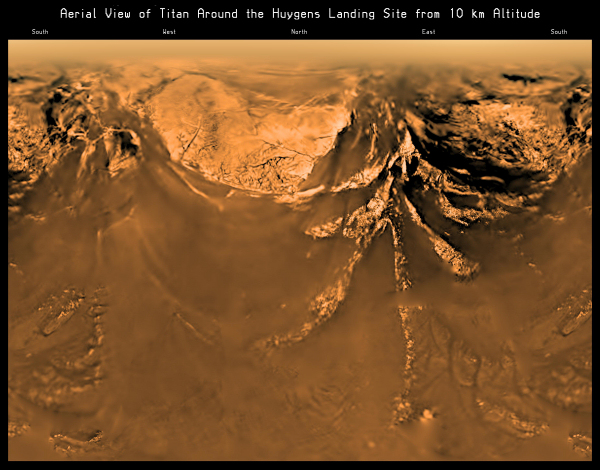

| Online: | |
| Visits: | |
| Stories: |

| Story Views | |
| Now: | |
| Last Hour: | |
| Last 24 Hours: | |
| Total: | |
Huygens: ‘Ground Truth’ From an Alien Moon
Although it may seem the stuff of science fiction, this scene played out 12 years ago on the surface of Saturn’s largest moon, Titan. The “aliens” who built the probe were us. This was the triumphant landing of ESA’s Huygens probe.
Huygens, a project of the European Space Agency, traveled to Titan as the companion to NASA’s Cassini spacecraft, and then separated from its mothership on Dec. 24, 2004, for a 20-day coast toward its destiny at Titan.
On Jan. 14, 2005, ESA’s Huygens probe made its descent to the surface of Saturn’s hazy moon, Titan. Carried to Saturn by NASA’s Cassini spacecraft, Huygens made the most distant landing ever on another world, and the only landing on a body in the outer solar system. This video uses actual images taken by the probe during its two-and-a-half hour fall under its parachutes.
Credit: Huygens descent video: NASA/ESA/University of Arizona/E. Karkoschka; Probe separation animation: NASA/JPL-Caltech; Probe landing animation: ESA
Thoughts on Huygens
Today the Huygens probe sits silently on the frigid surface of Titan, its mission concluded mere hours after touchdown, while the Cassini spacecraft continues the exploration of Titan from above as part of its mission to learn more about Saturn and its moons. Now in its dramatic final year, the spacecraft’s own journey will conclude on September 15 with a fateful plunge into Saturn’s atmosphere.
With the mission heading into its home stretch, Cassini team members and NASA leaders look back fondly on the significance of Huygens:
“The Huygens descent and landing represented a major breakthrough in our exploration of Titan as well as the first soft landing on an outer-planet moon. It completely changed our understanding of this haze-covered ocean world.” — Linda Spilker, Cassini project scientist at NASA’s Jet Propulsion Laboratory, Pasadena, California
“Cassini and Huygens have shown us that Titan is an amazing world with a landscape that mimics Earth in many ways. During its descent, the Huygens probe captured views that demonstrated an entirely new dimension to that comparison and highlights that there is so much more we have yet to discover. For me, Huygens has emphasized why it is so important that we continue to explore Titan.”
– Alex Hayes, a Cassini scientist at Cornell University, Ithaca, New York
“Twelve years ago, a small probe touched down on an orangish, alien world in the outer solar system, marking humankind’s most distant landing to date. Studying Titan helps us tease out the potential of habitability of this tiny world and better understand the chemistry of the early Earth.” — Jim Green, director of planetary science at NASA Headquarters, Washington
A collection of Huygens’ top science findings is available from ESA at: http://sci.esa.int/huygens-titan-science-highlights
The Cassini-Huygens mission is a cooperative project of NASA, ESA (European Space Agency) and the Italian Space Agency. NASA’s Jet Propulsion Laboratory, a division of Caltech in Pasadena, manages the mission for NASA’s Science Mission Directorate, Washington. JPL designed, developed and assembled the Cassini orbiter.
More information about Cassini: http://www.nasa.gov/cassini and http://saturn.jpl.nasa.gov
Contacts and sources:
Preston Dyches, Jet Propulsion Laboratory, Pasadena, Calif.
Markus Bauer, ESA
Source:



